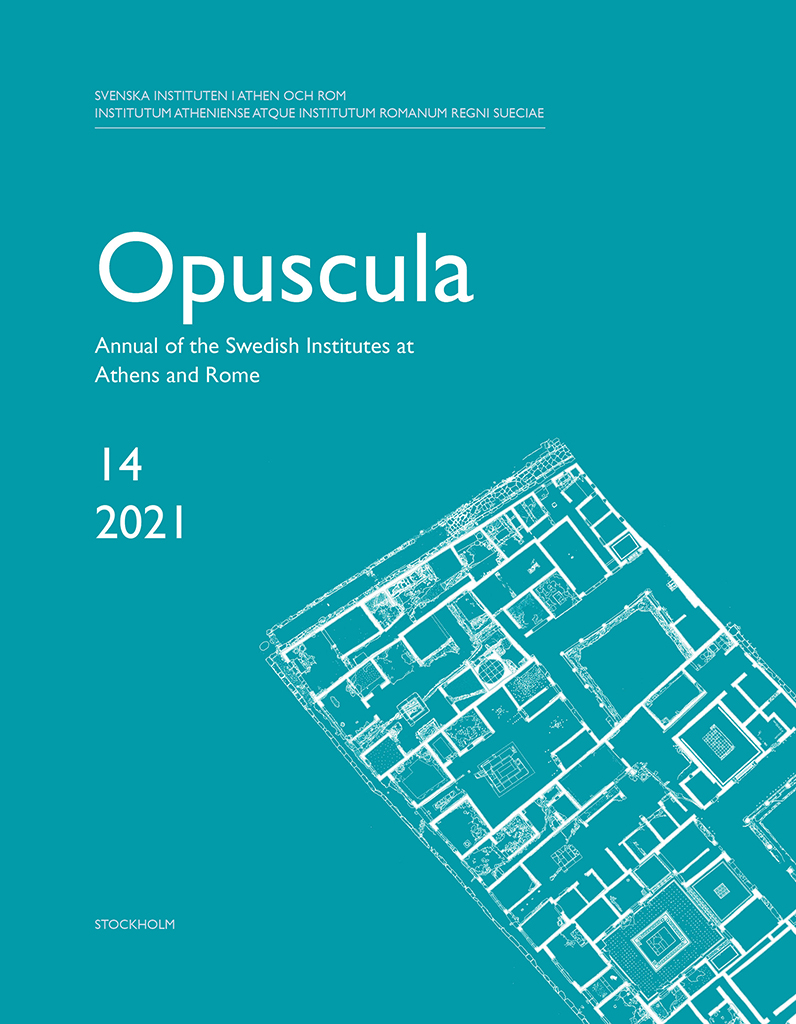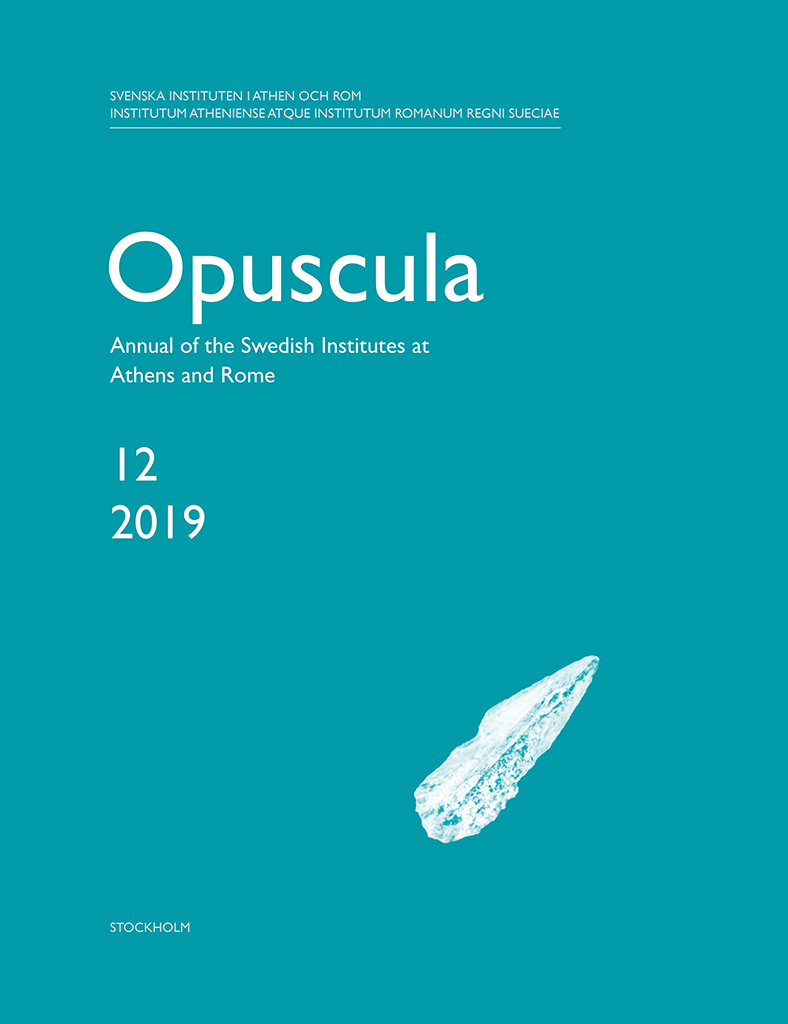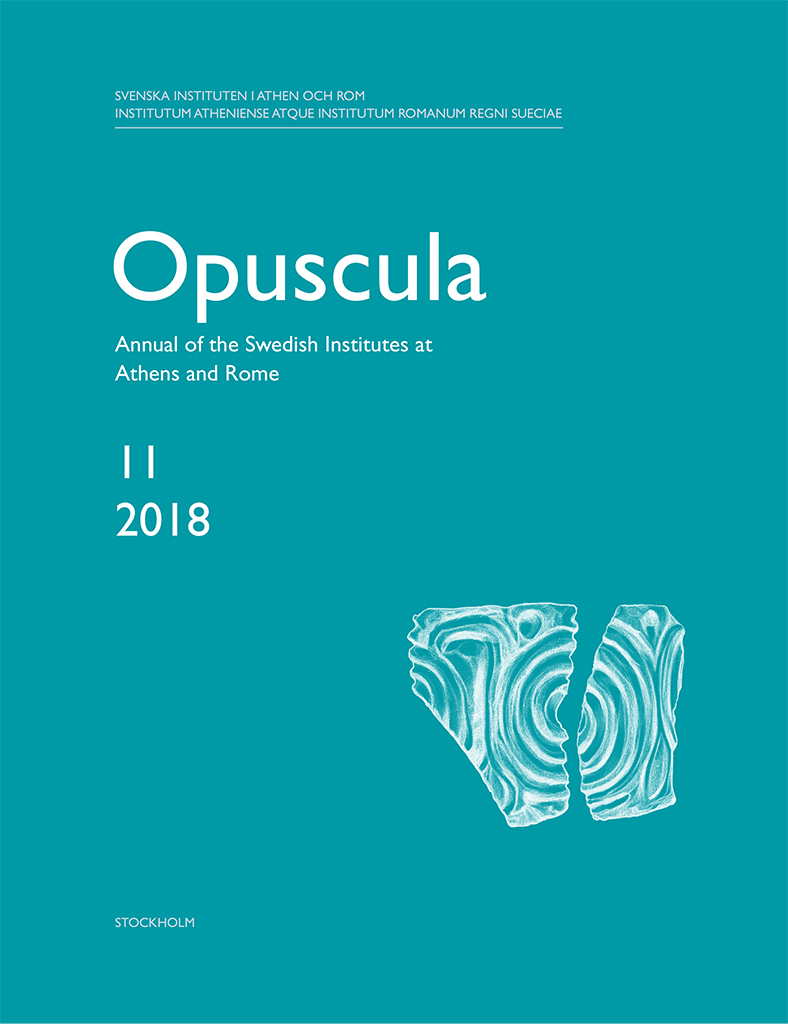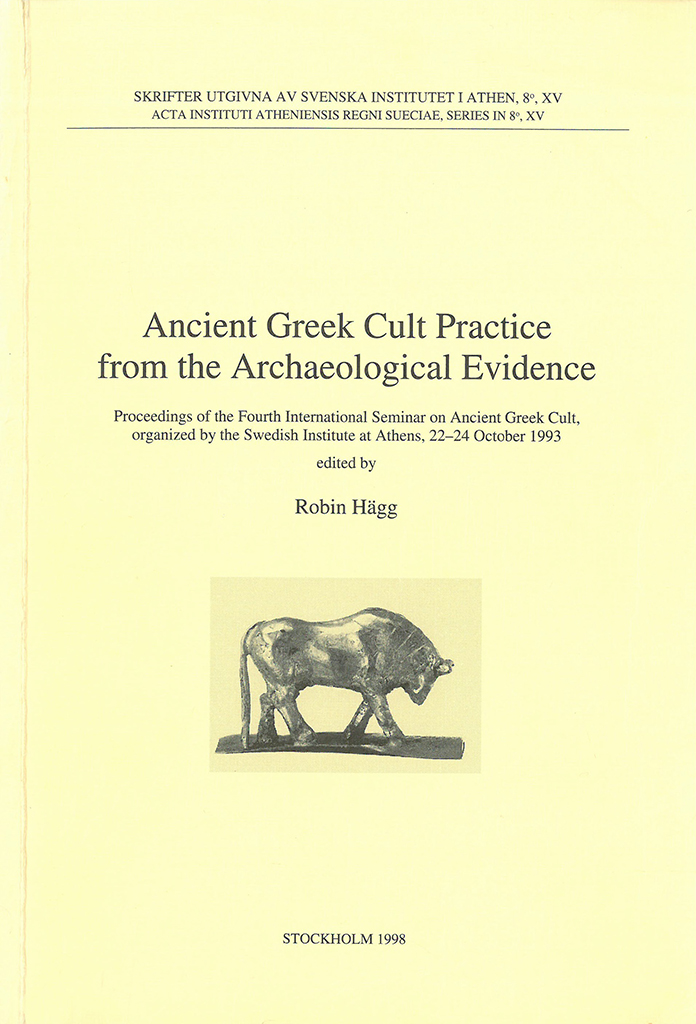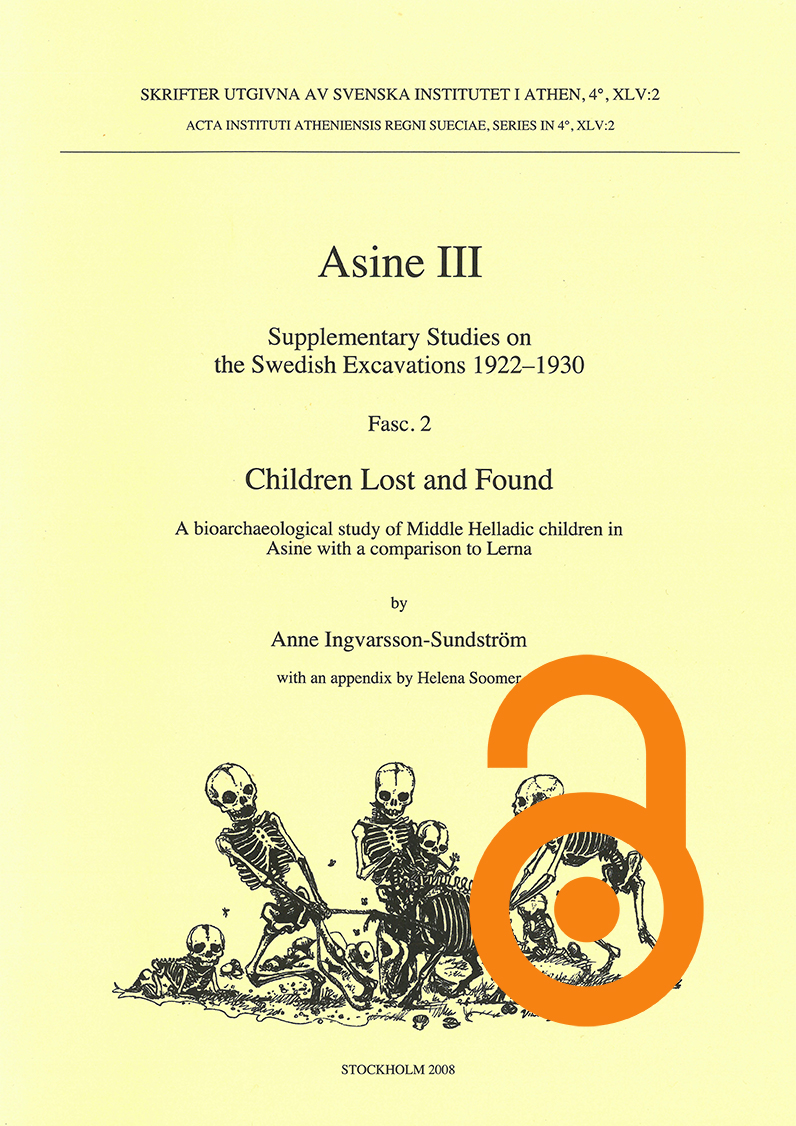Opuscula is published by the Swedish Institutes at Athens and Rome, with the aid of a grant from the Swedish Research Council. Distributed by Eddy.se AB. View journal at ERIH PLUS. All content available with open access. The Tomba Åström and the 1969 excavations at San Giovenale By Mattia D’Acri (Princeton University) & Fredrik Tobin-Dodd (Swedish Institute of Classical Studies in Rome) Abstract In June 1969, Paul Åström and a group of students from the Swedish Institute of Classical Studies in Rome conducted a small series of excavations at San Giovenale, an Etruscan site in the inland between Cerveteri and Tarquinia. The material was unpublished until now, but a study of the finds and archival material suggests that it primarily comes from a chamber tomb constructed in the second half of the 7th century BC, in the late Orientalizing period, and probably used for several burials. Bibliographical information Mattia D’Acri & Fredrik Tobin-Dodd, ‘The Tomba Åström and the 1969 excavations at San Giovenale’, Opuscula. Annual of the Swedish Institutes at Athens and Rome 17, Stockholm 2024, pp. 95–111. ISSN 2000-0898. ISBN 978-91-977799-6-8. Softcover, 280 pages. https://doi.org/10.30549/opathrom-17-06
Opuscula is published by the Swedish Institutes at Athens and Rome, with the aid of a grant from the Swedish Research Council. Distributed by Eddy.se AB. View journal at ERIH PLUS. All content available with open access. Gourimadi Archaeological Project. The results from the first excavation season (2018) of a prehistoric site in the Karystia, southern Euboea By Žarko Tankosić (University of Bergen, Norway), Fanis Mavridis (Greek Ministry of Culture and Sports, Greece), Paschalis Zafeiriadis (Norwegian Institute at Athens, Greece) & Aikaterini Psoma (University of Illinois at Chicago, United States of America) Abstract The Norwegian Institute at Athens received a permit from the Greek Ministry of Culture and Sports in 2018 to conduct a five-year excavation project at the site of Gourimadi in southern Euboea. The first field season, conducted in June 2018, lasted for four weeks during which two trenches were opened at the site and partially excavated by a Norwegian-Greek team of researchers and students. The aim of the project is to understand the transition from the Neolithic to the Bronze Age in this part of the Aegean in the light of emerging regional maritime interaction networks and lasting settlement of the Cycladic islands. In addition, data collected…
Published by the Swedish Institute at Athens. Distributed by Eddy.se AB. Agios Elias of Asea, Arcadia Vol. 1. Agios Elias of Asea, Arcadia. From early sanctuary to medieval village Edited by Jeannette Forsén Abstract A brief four-week excavation campaign in 1997 at the temple on top of the mountain of Agios Elias at Asea produced abundant archaeological material which partly is presented in this study, along with a stratigraphic report of part of the excavated area. The pottery, miniature vessels, miscellaneous terracotta finds, roof tiles, faunal and human bones, glass, coins, sculpture and miscellaneous stone objects are included in the present work. The first focus of activities at the site took place around c. 720–690 BC (Early Protocorinthian). No architecture was found in connection with this period. However, roof tiles of a temple and some auxiliary buildings from c. 590–560 BC (Middle Corinthian–Late Corinthian I) are accompanied by a large amount of pottery which point at a second floruit of the site during this period. Some of the pottery is local/regional, with other examples originating from many parts of southern Greece in addition to Attica and possibly East Greece as well. During the 14th century AD a village, named Kandreva,…
Opuscula is published by the Swedish Institutes at Athens and Rome, with the aid of a grant from the Swedish Research Council. Distributed by Eddy.se AB. View journal at ERIH PLUS. All content available with open access. Palaepaphos-Skales Tomb 277. More prestigious burials. With an appendix by Maria A. Socratous By Vassos Karageorghis (The Cyprus Institute, Cyprus) & Efstathios Raptou (Cyprus Museum, Cyprus) Abstract Tomb 277 in the Skales cemetery at Palaepaphos, excavated by the Cyprus Department of Antiquities, is among the richest ever found in the south-west of the island. It dates to the Cypro-Geometric III period (c. 900–750 BC) and was used for multiple burials of important members of the Palaepaphian society, namely warriors and important women (priestesses of the Great Goddess?) judging from the abundant offerings of arms and armour as well as gold jewellery respectively (including gold plaques embossed with the head of the Egyptian goddess Hathor). Notable among the offerings are two bronze basins, six small hemispherical bronze bowls, two bronze mace-heads (symbols of authority), a bronze shield of a rare type, and two richly decorated belts of oriental type. We also mention two iron swords and a bronze spearhead. Among the pottery we note…
Opuscula is published by the Swedish Institutes at Athens and Rome, with the aid of a grant from the Swedish Research Council. Distributed by Eddy.se AB. View journal at ERIH PLUS. All content available with open access. Two Early Helladic II terracotta rollers from Asine and their glyptic context By Michael Lindblom (Uppsala University), Gullög Nordquist (Uppsala University) & Hans Mommsen (Universität Bonn). Abstract Two Early Helladic II terracotta rollers from the Third Terrace at Asine are presented. The objects, used to impress relief decoration on pithoi and hearths, are unique in that no other examples are known from the Early Bronze Age Aegean. Their origin is discussed based on chemical characterization and their depositional contexts are reviewed from an archaeological perspective. Although there are no known impressions from these rollers on pithoi and hearths at Asine, it is shown that their owners surrounded themselves with different objects featuring similar glyptic impressions. Two such impressions find identical parallels at Tiryns and the combined evidence strongly suggest that Asine was the home for one or several potters who produced Early Helladic impressed hearths and pithoi. Bibliographical information Michael Lindblom, Gullög Nordquist & Hans Mommsen, ’Two Early Helladic II terracotta rollers from…
Opuscula is published by the Swedish Institutes at Athens and Rome, with the aid of a grant from the Swedish Research Council. Distributed by Eddy.se AB. View journal at ERIH PLUS. All content available with open access. The Swedish Jordan Expedition 2014 at Tall Abu al-Kharaz. Preliminary results from Areas 12 and 13 By Peter M. Fischer & Teresa Bürge Abstract In previous seasons excavations have concentrated on the periphery of the city of Tall Abu al-Kharaz, a multi-period tell in the Central Jordan Valley. Tall Abu al-Kharaz flourished from the Early Bronze to Islamic times, from roughly 3200 BC to the 10th century AD. The main object of the field work in 2014 was to investigate the area around the geographical centre of the city (Area 12). Preference was given to further investigation of the Iron Age sequence, i.e. the period from the 12th to the 7th centuries BC (local Phases IX–XV). Another task was to extend the excavations in the northern part of the city, Area 7, which produced essential information on the Iron Age, towards the south (Area 13) in order to generate a coherent picture of Iron Age occupation in the city’s northern half. Domestic structures…
Opuscula is published by the Swedish Institutes at Athens and Rome, with the aid of a grant from the Swedish Research Council. Distributed by Eddy.se AB. View journal at ERIH PLUS. All content available with open access. The Charitonidis Class: A group of large Athenian Late Protogeometric skyphoi By John K. Papadopoulos Abstract This article assembles and publishes a group of distinctive large Athenian Late Protogeometric skyphoi. Aspects of shape and decoration are fully discussed, so too the evidence for establishing the date of the group, as well as their distribution. The group, if not the potter, is named after the man who published two complete examples of the class from the South Slope of the Athenian Acropolis: Serapheim Charitonidis. Bibliographical information John K. Papadopoulos, ‘The Charitonidis Class: A group of large Athenian Late Protogeometric skyphoi’, Opuscula. Annual of the Swedish Institutes at Athens and Rome (OpAthRom) 8, Stockholm 2015, 7–26. ISSN: 2000-0898. ISBN: 978-91-977798-7-6. https://doi.org/10.30549/opathrom-08-02
Published by the Swedish Institute at Athens. Distributed by Eddy.se AB. All content is available with open access, use links below. Mastos in the Berbati Valley. An intensive archaeological survey Edited by Michael Lindblom & Berit Wells Abstract This study presents the results of a small but intensive surface survey conducted on the Mastos Hill in the Berbati Valley in 1999. While remains from the Early and Late Helladic period were known from previous excavations on its southern and eastern slopes, this is the first analysis of the entire hill. It includes a digital documentation of the local topography as well as an account of the archaeological remains retrieved in the field. The study fills a gap in different data sets and results gained through old excavations and the extensive 1988–1990 Berbati-Limnes survey. The introductory chapter summarizes previous work in the valley, discusses its ancient routes of communication and outlines the method employed in the archaeological survey. This is followed by an account of the topographical survey and the geographical information system used. In the six following chapters the archaeological remains are presented and analyzed in a diachronic fashion. It is concluded that the hill was predominantely settled in prehistory…
Published by the Swedish Institute at Athens. Distributed by Astrom Editions. Ancient Greek cult practice from the archaeological evidence. Proceedings of the Fourth International Seminar on Ancient Greek Cult, organized by the Swedish Institute at Athens, 22–24 October 1993 Edited by Robin Hägg Abstract A collection of thirteen papers, read at an international seminar in Athens, that deal with various phenomena of Greek cult practice, analyzing the information gained from the archaeological evidence. Among the special topics discussed are cult practice in the acropolis sanctuary of Minoa on Amorgos, the sanctuaries in the Artemision of Ephesos, the role played by osteological analysis in the understanding of Greek sacrificial practice, the interpretation of animal bones and fire traces connected with ritual feasting in the Herakleion on Thasos, ritual and society in Early Iron Age Corinthia, small dedications from the Archaic temple of Poseidon at Isthmia, altars in Greek hero cults, the early history of the sanctuary of Demeter and Kore at Eleusis, a sacrificial area near the sanctuary of Apollo Daphnephoros at Eretria, terracotta plaques and other finds from the sanctuary of Demeter and the Dioscouri at Messene, the interpretation of sickles in Greek sanctuaries, changes in votive practice from Classical…
Published by the Swedish Institute at Athens. Distributed by Astrom Editions and Eddy.se AB. Asine 3. Supplementary studies in the Swedish excavations 1922–1930 Fasc. 1. Supplementary studies in the Swedish excavations 1922–1930 Edited by Robin Hägg, Gullög C. Nordquist & Berit Wells Abstract This is a collection of eleven papers inaugurating a new series of supplementary studies on the material from the old Swedish excavations at Asine. The first is a summary of the work undertaken between 1922 and 1930 and is intended to help in the study of the published reports and of the unpublished documentation. In further papers additional information is given on the Middle Helladic graves of the Lower Town, the Late Mycenaean terracotta head called “The Lord of Asine” is re-studied, and pottery and small finds from Mycenaean chamber tombs are discussed, including some technical aspects, such as the use of tin foil on pots. A group of Mycenaean vases from the village of Zafer Aga is published for the first time. Another paper deals with the animal bones from the Lower town of Asine. Finally, a concordance of the numbers of the graves and skeletons found at Asine is given as a tool for scholars…


